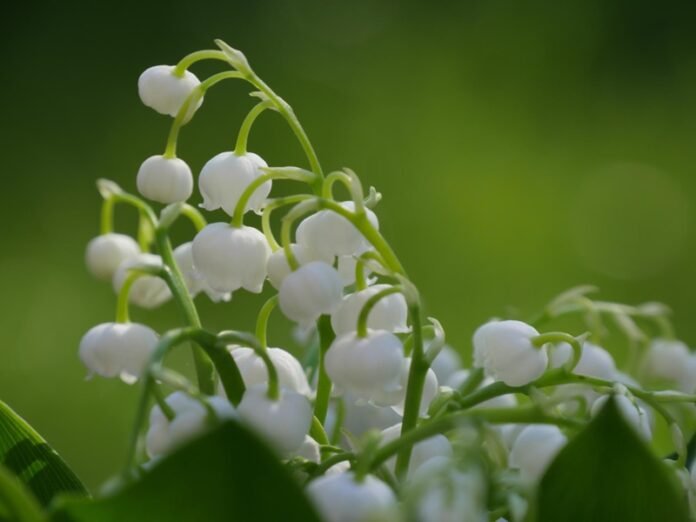Lily of the Valley (Convallaria majalis) typically blooms in late spring, around May, although the exact timing can vary depending on the climate and growing conditions. In cooler climates, blooming may begin in early May, while in warmer regions, it might start in late April or early June. The flowering period generally lasts for about 3-4 weeks, during which the plant produces its signature, sweetly scented flowers.
When is Lily of the Valley in season?
Lily of the Valley (Convallaria majalis) typically blooms in the spring. In most regions, it is in season from late April to early June. The exact timing can vary depending on the climate and geographical location. In warmer regions, the flowers may appear as early as mid-April, while in cooler areas, they might not bloom until late May.
In France, Lily of the Valley is traditionally associated with May Day (May 1st), when it is customary to give small bouquets of these flowers as a token of good luck and happiness. This tradition underscores the peak blooming period of Lily of the Valley in early May.
Environmental Factors Affecting Blooming
- Temperature: Cooler temperatures in early spring can delay blooming, while warmer conditions may accelerate it.
- Light: Lily of the Valley prefers partial to full shade. Too much direct sunlight can scorch the leaves and affect blooming.
- Soil Moisture: Consistently moist soil helps ensure a robust flowering period. Drought conditions can shorten the blooming time and reduce flower quality.
Extending the Blooming Season
While the natural blooming period of Lily of the Valley is relatively fixed, there are a few strategies to enjoy their beauty for a longer time:
- Successional Planting: Planting pips in different garden microclimates can stagger blooming times slightly.
- Companion Planting: Pairing Lily of the Valley with other shade-loving perennials that bloom earlier or later can extend the overall flowering display in your garden.
Post-Bloom Care
After the blooming season, the flowers will fade, and the plant will focus on foliage growth and root development. Here’s how to care for Lily of the Valley post-bloom:
- Deadheading: Remove spent flowers to tidy the plant and prevent seed formation, which can drain energy from the plant.
- Foliage Maintenance: Allow the leaves to remain until they yellow and die back naturally. This process helps the plant store energy for the next growing season.
- Division: If the plants become overcrowded, divide them in the fall to ensure healthy growth and flowering in the following season.
Flower Characteristics
- Classic White Blooms: The traditional lily of the valley flowers are small, bell-shaped, and white. They grow in clusters on one side of a slender, arching stem, creating a delicate and elegant display.
- Fragrance: The flowers are renowned for their strong, pleasant fragrance, which is a major reason for their popularity in gardens and floral arrangements.
- Longevity: While the blooming period is relatively short, the flowers’ impact is long-lasting, leaving a fragrant memory in the garden.
Variations in Flower Color
Although the classic Lily of the Valley is white, there are several variations that offer different hues:
- Pink Lily of the Valley (Convallaria majalis ‘Rosea’):
- Appearance: This cultivar features the same bell-shaped flowers as the classic variety, but in a delicate shade of pink.
- Popularity: The pink lily of the valley is a popular choice for gardeners looking to add a subtle splash of color to shaded areas.
- Blooming Period: It blooms at the same time as the white variety, offering a charming contrast in the garden.
- Blue Lily of the Valley:
- Misconception: True blue lily of the valley does not naturally exist. However, some gardeners might refer to certain blue-tinted flowers or closely related species as blue lily of the valley.
- Alternatives: For those seeking blue flowers in a similar form, consider other plants such as bluebells (Hyacinthoides non-scripta) which bloom around the same time and can complement lily of the valley in a garden setting.
By understanding the blooming seasons and flowering period of Lily of the Valley, including variations like the pink lily of the valley and knowing about the non-existence of a true blue lily of the valley, gardeners can better appreciate and cultivate this enchanting plant. With proper care and attention, Lily of the Valley can provide years of beauty and fragrance in shaded garden areas.
FAQs:
Most lilies bloom during the summer season, typically from early to late summer, depending on the species and growing conditions.
Lily of the valley usually blooms in May, though in some regions with different climates, it can bloom in late April or early June.
Lilies grow up during the spring and early summer seasons, developing their foliage and preparing to bloom during the height of summer.
Most lilies do not bloom in winter as they require a period of dormancy in colder weather. However, certain varieties, like some species of indoor lilies or lilies grown in warmer climates, may bloom out of their typical season.
The December lily, also known as the Christmas lily, often refers to the Amaryllis, which is known for its large, trumpet-shaped flowers that typically bloom around the holiday season.
Lilies are perennial plants, meaning they return year after year. While the flowers do not bloom all year round, the bulbs remain dormant in the soil during the off-season, ready to grow and bloom again in their proper season.















